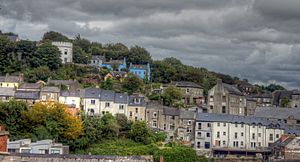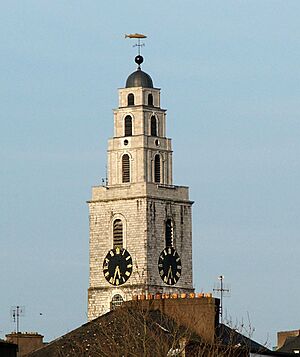Shandon, Cork facts for kids
Quick facts for kids
Shandon
Seandún
|
|
|---|---|
|
City district
|
|

Houses in the Shandon area
|
|
| Country | Ireland |
| Province | Munster |
| City | Cork |
| Time zone | UTC+0 (WET) |
| • Summer (DST) | UTC-1 (IST (WEST)) |
Shandon (which means "the old fort" in Irish, An Seandún) is a cool part of Cork city in Ireland. It's located on the north side of the city. Shandon is north of the River Lee and the old North Gate Bridge. This bridge was once the most northern point of the city long ago.
Many important places in Cork's north side are in Shandon. These include the famous bell tower of the Church of St Anne, the Cathedral of St Mary and St Anne, and the Saint Mary’s Dominican Church & Priory. The Firkin Crane Arts Centre is also here.
Shandon is even mentioned in a famous song called "The Bells of Shandon". A writer named Francis Sylvester Mahony wrote it using the pen name "Father Prout". Shandon Street is a main road in this area. It used to be called Mallow Lane. Shandon is part of a voting area called Cork North-Central. This area helps choose people for the Irish parliament, known as the Dáil.
Contents
History of Shandon
Shandon was one of several small towns or settlements around ancient Cork. Its name comes from an old fort, or sean dún, that was in the area. A church for St. Mary was built near this fort in the Middle Ages. Texts from the 1100s called it 'St. Mary of the Mountain'.
Later, a castle was built near where the old fort stood. This castle, called Shandon Castle, became the home of the Lord President of Munster. This important leader lived there starting in the 1500s. Both Shandon Castle and the first St. Mary's church were destroyed during a big fight called the Siege of Cork in the late 1600s.
Shandon Street was first known as Mallow Lane. The Anglo-Normans, who came to Ireland a long time ago, built this street. It helped people get to the North Gate drawbridge, which was an important entrance to the city.
Fun Events in Shandon
The Shandon Street Festival is a special event that happens every year. It takes place during the summer months. It's a fun time for everyone in the community.
People of Shandon
In 2016, about 3,144 people lived in the Shandon area. This includes two voting areas, Shandon A and Shandon B. Most people living there were Catholic (50%). About 16% belonged to other religions, and 26% said they had no religion. About 8% did not say what their religion was.
Famous Places to See
Shandon has many interesting buildings and places to visit.
Religious Buildings
- The Cathedral of St Mary and St Anne is a Catholic church. People in Cork often call it the "North Cathedral".
- The Church of St Anne belongs to the Church of Ireland. It's famous for its bells and is known as "St Anne's, Shandon".
- Saint Mary's Dominican Church is another Catholic church. It is located on Popes Quay.
Other Landmarks
- The Firkin Crane is a special place for theatre and dance performances.
- The Cork Butter Museum teaches you all about the history of butter making in Cork.
- The Shandon Craft Centre is a great place to see local crafts.
- Skiddy's Almshouse is a historic building that used to provide housing for poor people.
People Connected to Shandon
Many interesting people have connections to Shandon:
- John Arnott (1814–1898): He was a very important person, known as the 1st Baronet Arnott of Woodlands, Shandon.
- William Black (1841–1898): This Scottish writer wrote a book called Shandon Bells in 1883.
- Patrick Hennessy (1915–1980): He was a talented painter.
- Jack Lynch (1917–1999): He was a very important politician who became the Taoiseach (Prime Minister) of Ireland.
- Ignatius O'Brien (1857–1930): He was a lawyer and politician, known as the 1st Baron Shandon.
- Jimmy McCarthy (born 1953): He is a songwriter. His song "The Mad Lady and Me" mentions "Shandon Bells" in its chorus.




